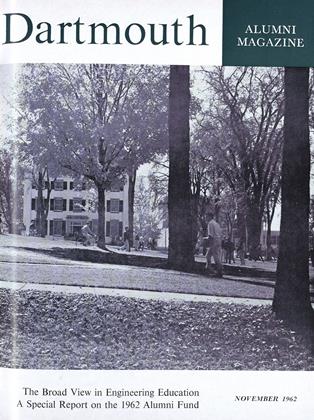By Herbert L. Marx Jr. '43. New York:H. W. Wilson Company, 1962. 191 pp.$2.50.
The Reference Shelf is a series of volumes devoted to timely, and frequently controversial, topics. Each one is a compilation of selections, chosen by the editor from such varied sources as magazines, books, pamphlets, newspapers, and government publications. Taken together, the contributions provide background information, as well as a picture of the varied aspects of the topic and opinion on it. The editor supplies a preface, plus an explanatory introduction setting the background for each major section. As this description illustrates, the books, are familiar to high school pupils and college students, because of their usefulness not only for debate topics but, also, due to their comprehensive treatment of many subjects of current interest. The full bibliography of books, pamphlets, documents, and periodical articles which concludes each volume merits additional thanks from reference librarians as well.
State and Local Government is the eighth of the Reference Shelf volumes which Herbert Marx has edited. Earlier ones have centered upon such diverse subjects as. Defense and National Security, CommunityPlanning, Television and Radio in America, and Gambling in America.
There are six major sections in this mostrecent book. Part I is entitled "Local Government Today," and the city expanded into the suburbs is the subject of Part II. The next section is devoted to state government and some aspects of its machinery.
Compacts and authorities are discussed in the fourth section, the coverage of the volume having now ranged from local government to the level of arrangements between states, requiring in the case of compacts Congressional approval, but still short of actually turning over problems for solution to the Federal Government. "The Right to Representation," Part V, studies some of the imperfections of democratic practices, and the final section concerns the role of the Federal Government (one of the first two articles in this section being by Lane Dwinell '28 in which the former New Hampshire governor encourages local, rather than national, action and de-emphasizes "big government").
The selections which the editor has included give the reader a stage-by-stage picture of many, but not all, of the problems of state and local government. There are areas outside the scope of the volume, and he refers the reader to related numbers of the Reference Shelf for additional information. The present volume, however, offers a compact portrayal which will serve as both an informative treatment in itself and as a starting point for more extensive research.
 View Full Issue
View Full Issue
More From This Issue
VIRGINIA L. CLOSE
Books
-
 Books
BooksOUR LIVING GOVERNMENT.
November 1960 By FRANK SMALL WOOD '51 -
 Books
BooksTHE FALL LINE: A SKIER'S JOURNAL.
NOVEMBER 1969 By HOWARD P. CHIVERS '39 -
 Books
BooksFUNDAMENTALS OF SKIING
April 1949 By John M. Piane '14. -
 Books
BooksPATTERNS IN THACKERAY'S FICTION.
APRIL 1970 By KENNETH PAUL '69 -
 Books
BooksWINKING WILLIE
December 1948 By LORNA GAHAGAN, Distaff '35. -
 Books
BooksHMS CEPHALONIA.
OCTOBER 1969 By VINCENT E. STARZINGER











